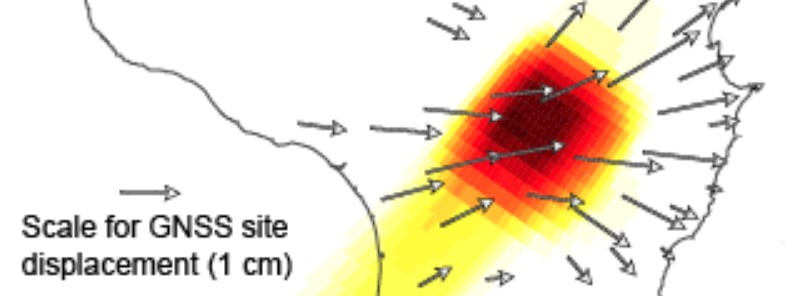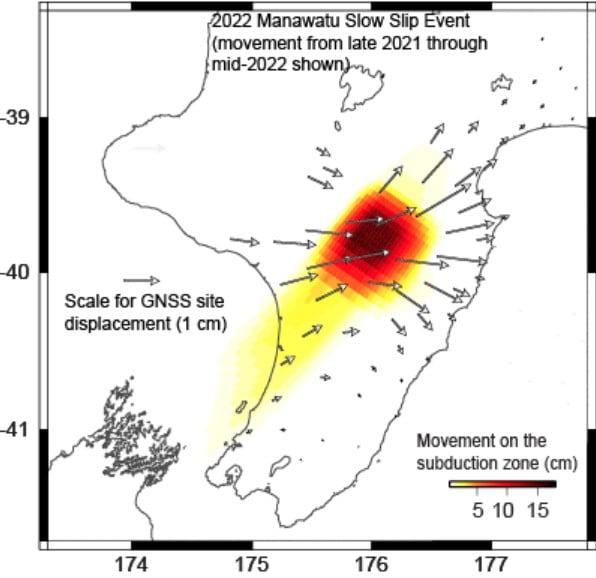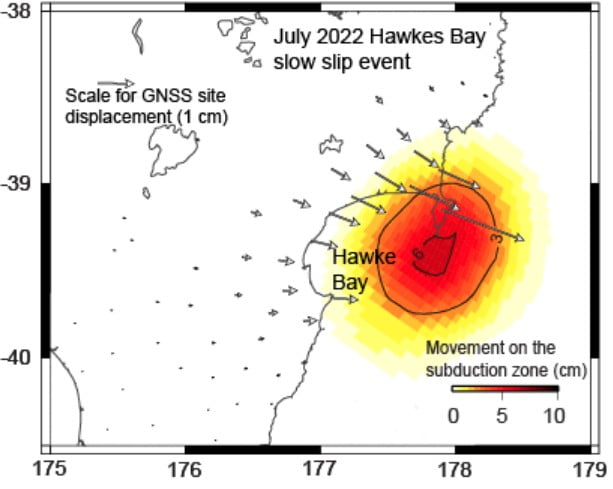Two slow-motion earthquakes under North Island, New Zealand

Two slow-motion earthquakes have been taking place so far in 2022 under the central and eastern North Island, New Zealand. These events are like earthquakes in slow motion, unfolding over weeks to months and cannot be felt by humans.
In late 2021, GeoNet reported that a deep slow-slip event had begun beneath Kāpiti in the lower North Island.
Since the beginning of 2022, that slow-slip event has traveled north beneath Manawatū. A few weeks ago, scientists also began to record a second slow-slip event off the shore of Hawke’s Bay, but this event now appears to be over.1
The Hikurangi subduction zone – the boundary between the Australian and Pacific Plates – extends along the east coast and dives westward underneath the North Island and hosts frequent slow-slip events on the shallower part of the subduction zone off the east coast. The short-lived event that just wrapped up in Hawke’s Bay is a good example but this year, the deeper portion of the plate boundary beneath the Manawatū area has been slowly slipping too.
GeoNet last recorded a slow slip in the Manawatū area about 6 years ago. Given that they typically happen about every 5 years or so, their scientists have been expecting this event to happen.
Some 30 -50 km (18 – 31 miles) beneath Manawatū, the Pacific Plate started moving slowly again in January after being ‘stuck’ to the overlying Australian Plate.
Although the Manawatū event appears to be slowing down somewhat, based on previous slow-slip events there, scientists say that it could continue off-and-on for the rest of 2022.
So far, scientists recorded about 15 cm (5.9 inches) of movement along the subduction zone plate boundary beneath the central North Island.
“We’d typically see 3.5 cm (1.3 inches) of movement there each year, so this is over four years’ movement in just seven months,” GNS SCceince Geophysicist Laura Wallace said.
“The slip has also caused up to 2 – 3 cm (0.8 – 1.2 inches) of surface movement (mostly eastward and upward) of GeoNet GPS sites above the slip. Interestingly, this amount of movement over the past 6 months is equivalent to what could happen in a M6.9 earthquake.”

The short-lived Hawke’s Bay slow-slip event that started in late June 2022 appears to have finished up in mid-July.
It caused up to 2 cm (0.8 inches) of displacement at some GPS sites along the east coast of the North Island above the subduction zone.
This is indicative of more than 7 cm (2.7 inches) of movement on the subduction zone offshore beneath Hawke Bay. The movement on the plate boundary in this Hawke’s Bay slow-slip event is equivalent to a M6.8 earthquake.

Combined, this year’s Hawke’s Bay and Manawatū slow-slip events have involved total movement on the Hikurangi subduction zone equivalent to a M7 earthquake.
“It’s possible that the Manawatū slow-slip event caused stress changes on the plate boundary which led to the Hawke’s Bay slow slip event. We have observed this in the past, when a similar sequence of deep (Manawatū) and shallow (Hawke’s Bay) slow-slip events occurred simultaneously in 2011 and 2015,” Wallace said.
References:
1 2022 Manawatū and Hawke’s Bay slow-slip activity – GeoNet – July 28, 2022
Featured image credit: GeoNet

Commenting rules and guidelines
We value the thoughts and opinions of our readers and welcome healthy discussions on our website. In order to maintain a respectful and positive community, we ask that all commenters follow these rules:
We reserve the right to remove any comments that violate these rules. By commenting on our website, you agree to abide by these guidelines. Thank you for helping to create a positive and welcoming environment for all.